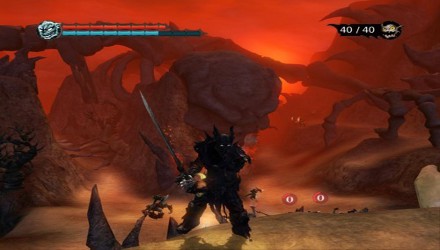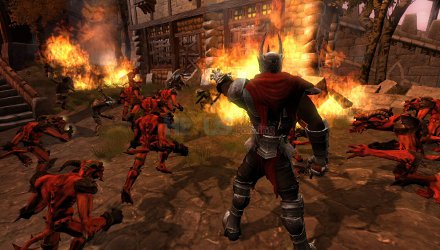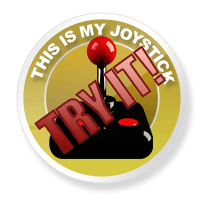Reviews
Review: Overlord II
June 26, 2009, Author: Trent Pyro
Video games are all the same. You play the hero, fighting evil and ridding the land of it. Whether it’s angry aliens or fiery demons, developers preoccupation with inherently ‘good’ protagonists has existed since the dawn of gaming. Who wants to play the bad guy, right? Well in 2007 Triumph Studios turned the whole idea on its head with Overlord, a game where you play the bad guy trying to take over the land. Players loved it, and it garnered moderately good reviews from the big press.
A couple of years later, and a sequel was released. Following pretty much the same premise, with a few tweaks here and there, players could once again assume the role of a demon prince tasked with conquering a fantasy land. Have the new improvements made the concept any better? Let’s find out…
In a distant land, where everyone talks funny…
Like I said, Overlord 2 casts you as a demon lord. Hounded and bullied as a child, your minions find you being cruelly pelted with snowballs by some of the local kids. After assisting you in teaching the little scumbags a lesson, your little brown friends lead you to your demon tower and after a fade-to-black passage of time, you’re now a fully grown badass.
The plot goes a little skewed here and doesn’t really straighten out. The main problem is that your Overlord has no personality, a silent, faceless goon that you puppeteer around. Thankfully, your minions are full of life, quips and hilarious traits but even that doesn’t make up for the lack of a strong protagonist. Despite this error, the story does have some direction and chief minion, Gnarl, manages to keep it on track for the most part. Following on from the events of the previous game (but not so much it requires you to have played it), you must conquer the land once again, this time snatching it from the grasp of the Roman-like ‘Glorious Empire’. One of Overlord 2’s strengths is its satirical and occasionally cynical view on the fantasy genre. Nothing is sacred; elves are misguided hippies, the Empire is full of fat captains and thick troops and the townspeople are ‘ye old English’ folk of Fable-like idiocy.
This humour helps the grim concept avoid becoming an uncomfortable one but adds nothing to the solidity of the story. There’s so much to do and see, so many objectives and side-quests that it’s too easy to get lost in the lists. From what I gathered, the main plot deals with taking over the land either by Destruction (levelling everything and committing genocide) or Domination (enslaving the population and keeping the towns intact). Somewhere there’s a plot thread linking the locations and objectives together, but to be honest it never enthralled me. Tasks become paramount, with no real feeling of following a trend or quest. This is not game-breaking, however, as Overlord 2 is actually a lot of fun.
Yes master!
The basis of Overlord 2’s gameplay lies in the minions. Able to command a number of them, the player must send them out to fight, collect items, smash stuff up and generally cause havoc. They come in four varieties; brown for melee, red for fireballs, blue for magical stuff and greens for stealth and poison. These distinct types help in different situations, and the game gives you ample chances to use all of them. Using a simple system, you can select one type at a time and give them individual orders, which allows for some effective strategy. Set up the reds on a hill, poised to pelt the enemy with fire, then send some greens in to sneak attack and finally send forth the browns to beat the living daylights out of the pompous Empire! This is but one of the many possible approaches to each battle, and this gives Overlord 2 a sense of RTS freedom withheld from many games of the same genre.
Talking of genre, trying to label Overlord 2 is tricky. It’s obviously fantasy, but with Industrial Revolution-style technology dotted around. Historical periods meld seamlessly into one, working together brilliantly. Hacking and slashing is handled reasonably well, if a little plainly, but the use of the minions keeps Overlord 2 out of the Fable stable. This variation in style is one of the game’s chief strengths, but unfortunately becomes its main weakness pretty quickly.

Lost? Confused? Now you know how I feel bozo...
Ordering the minions is simple enough, but can get fiddly in a jam. It’s practically impossible to exact an efficient strategy when you’re on the back foot, unless legging it and holding RT to send every minion you’ve got to battle is your idea of a strategy. Fighting alone is also suicide; as the game progresses even the weakest enemies become a chore to hack down by yourself, forcing you to pour minions in. I suspect this was the intention, a cheap but effective way of making the player use and appreciate the little gremlins, but resisting the urge to go in swinging is tough. The difficulty spikes wildly at times; every enemy in a level will be easy pickings, only for the boss to be a horrendous uphill struggle. Objectives are confusing and badly signposted much of the time, leading to endless hours running around trying to figure out what to do. Expanding your horde is another problematic task. You must find special stones to increase your horde size; essential if you want to survive the latter sections of the game. The problem is, these stones are hidden, much of the time in obscure and random locations. Secrets should be optional and fun, not a necessity for survival.
It seems Triumph have tried to cram as much content into Overlord 2 as possible. This is good; at least you’re getting a decent chunk of game for your money. It soon becomes a nightmare to keep on top of, though. Your Demon Tower has a Forge to create new weapons and armour and a Minion area to upgrade and organise your little helpers, but both are so complicated I felt inclined not to use them. To forge a weapon, for example, you must have enough money, enough life force points, the correct forge stone and at least two other objects that I can’t figure out. It feels more like pot-luck than a calculated guess as to whether you are able to get a particular sword or chunk of armour. Why make it this complex? Most games get by just fine with a basic currency, and maybe one or two other (easy to understand) factors. Due to this complexity, even in the closing chapters of the game, I still had no idea how to use half of the game’s features, only fluent in the mechanics the game chose to teach me properly. It’s over complicated and difficult to understand; a death wish for some gamers that draws a confused and baffled look to my face.
Hey, Fable 2! No, wait…
The first thing I noticed about Overlord 2 was how unoriginal it looked. Not in its design; as I mentioned before, the enemies and characters are inspired and brilliant. What I mean is, the style is almost identical to that of another, slightly more successful franchise.
The houses are odd and cartoon-like, the people have bulbous features and strange walking patterns. I racked my brains for a while, trying to figure out why it all looked so familiar. It wasn’t until one of the locals insulted me that I cracked it. The design of everything feels so heavily influenced by Lionhead’s Fable it’s incredible. This isn’t bad; the style works well enough and brings some humour to the grim murder, enslavement and conquering. I couldn’t escape the feeling that I was playing… ok, I’ll say it, Fable 2.5 for the most part. Considering my anticipation of Fable 3 can be compared to that of a kid on Christmas Eve, constant reminders of Peter Molyneux’s masterful series grated on me quickly and often.
Spec-wise, Overlord 2 doesn’t amaze. The textures are smooth, sure, and the sun is shiny and bright. Occasionally I came across a vista that made me stop, but nothing to top the likes of what Fallout 3 and Oblivion can muster. The enemy designs are interesting, but the lack of fine detail in the rendering means they all start looking like clones of each other. In all it’s not bad; just not jaw-dropping.

By far the most enjoyable aspect of the game... MINDLESS DESTRUCTION!
“Get orf my laaaaaand”
Overlord 2’s sound is nothing special. Swords swing, enemies shout, stuff explodes. The only audio worth noting is the voice acting of the civilian townsfolk and the Minions.
Why Triumph decided to clone Lionhead’s idea of using irritating, Ye Olde-farmer voices for its commoners is beyond me. It was one of the things that annoyed me the most about Fable; everyone either talked in a cockney slur or a grass-chewing, West Country drawl. Neither of these accents were correct of course; forced, overused stereotypes that grated immensely. Overlord 2’s people are the same, albeit with an absence of London-speak. Everyone sounds the same; it’s as if they got one man and one woman to do all the voices. It’s a very old trick, one which I thought had died with the last generation of consoles. It’s also a perfect way to make your game sound cheap and rushed.
The Minion voices, however, are at the opposite end of the scale. While individual Minions sound the same, each colour has a distinct vocal style. The little things are not limited to accepting and rejecting orders either; they come out with all manner of chucklesome quips and occasionally creepy remarks. Minion sage Gnarl sounds like the narrator in 300 (FYI: it’s not him, I checked!) and releases useful information to keep you on track as well as adding some light relief to almost every cut-scene. Even Forge Master Giblet has a unique voice, adding another layer of personality to the minion ranks. This is unfortunately the only sound worthy of mention, making Overlord 2 a decidedly bland auditory experience.
Reds vs Blues
Multiplayer was clearly not Trimph’s top priority when crafting Overlord 2, but it seems they decided to crowbar it in anyway. I get the feeling their hand was semi-forced by the game’s RTS-leanings and they somehow thought strategy fans would be upset if multiplayer wasn’t offered. Now, my personal opinion of Overlord 2’s online japes is probably a little biased, as you’ll see. So first I’ll explain the basics before giving my honest opinion.
Taking the form of both competitive and co-operative game types, multiplayer allows you to battle other people online. In the co-op corner you’ve got Survival and Invasion. The former seems to be like every other survival mode in every other game; defend yourself for as long as you can. The latter involves you and a mate taking on increasingly difficult foes together. Joy.
The competitive among us have Dominate and Pillage to quench their thirst for winning. Dominate is a standard area-capture game, where rival Overlords must hold as many blocks of land as they can, the winner being the person with the most at the end of the match. Pillage unsuccessfully tries to shake things up by replacing the areas of land with piles of treasure. Not exactly varied, but decent enough for a game where the single player is obviously the intended main concern.
Ok, so that’s how it’s supposed to be. Unfortunately, it doesn’t quite explain the experience I had. After struggling for over a half-hour to get a match, possibly due to the muted popularity of the game, I connected and was immediately booted out by the system. A few more tries and I managed to stay in a game long enough to have my arse handed to me in a Dominate match. Twice over. As with many sleeper hits and games that didn’t sell amazingly, the only people playing the multiplayer are the rock-solid elite and newbies giving it a try like me. This makes the mode almost inaccessible to newcomers, requiring dedication and practise to become enjoyable. The lack of innovative modes and the game’s general performance online don’t feel worth the investment of time, and so Overlord 2 falls into the dreaded category which I like to call ‘The Elite Fleet’. Sounds good, but it really isn’t.
…miserably ever after. The end.
Overlord 2, like so many other games, isn’t bad. It’s fun to play, has some nice ideas and has more content than your average TV channel. It’s reasonably lengthy and will keep you occupied for a weekend or so; if you can stand it that long. Its problems really get under your skin, be it leading to screaming orders at your Minions because they went the wrong way or refuse to come back, putting the controller down in frustration because you’re overrun and you know you can’t do anything about it, scratching your head with absolutely no idea what to do, and so on. There are just too many issues for me to wholeheartedly recommend it, but it’s worth a shot if you want a decent slasher with a few new twists and ideas.
Platforms: PC, PS3, Xbox 360 | Tagged annoying, confusing, demons, destruction, fun, hack, minions, olde english, overlord, slash, tiresome, try it



